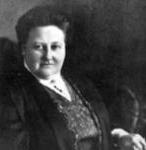Biography

Amy Lowell was born in 1874 on her family’s estate, Sevenels, in Brookline, Massachusetts. The youngest of five children, she developed an affection for books and a love of reading and writing at an early age. Lowell and her mother, Katherine, composed and published a book of stories and poetry called Dream Drops; or, Stories from Fairyland in 1887. While she seemed diligent in her studies of literature, Lowell’s schoolteachers reported her as undisciplined and a troublemaker, teasing her classmates and disrespecting those in authority. It was also stated that Lowell was prone to openly voicing her strong opinions, a trait that would remain dominant in her character for many years to come.
Lowell was not allowed to pursue a higher education after her debut into society, but the upper-class Lowell family traditions hadn’t accounted for the young woman’s hunger for literature. … [Lowell’s published writing expanded from just poetry to critical reviews of other poets, as well as essays in support of the Imagist poets] …She set to reading as much as possible in her family’s enormous 7,000-volume library and also began collecting books. In 1902, after both her mother and father died, Lowell decided that she was destined to become a poet. She commenced writing and submitting her poems to magazines and journals, many of which were published. Her first volume, A Dome of Many Colored Glass, was printed in 1912 but was not received well, publicly or critically.
That same year, Lowell met Ada Dwyer Russell, an actress who became the poet’s companion for the rest of her life. Lowell’s published writing expanded from just poetry to critical reviews of other poets, as well as essays in support of the Imagist poets, a literary group with whom she identified and for whom she avidly advertised. She continued to concentrate on her poetry, introducing “polyphonic prose,” the general abandonment of all lyrical laws within a work of poetry, with her collections Sword Blades and Poppy Seeds (1914) and Men, Women, and Ghosts (1916).
Lowell’s literary inspirations varied greatly, and always showed significantly in her work. Her 1919 poetry publication, Pictures of a Floating World, reflected her interest in Oriental art, as did her translations and reconstruction of Chinese poems in Fir-Flower Tablets (1921). Her extensive biography, John Keats, published in 1925, made clear her love of the poet. Lowell also supported her contemporaries, becoming actively involved in the publication of many of the Imagist poets’ collections.
Lowell died in 1925 at Sevenels. Posthumously, a collection of her poetry edited by Ada Dwyer Russell titled What’s o’Clock was published in 1925 and was awarded a Pulitzer Prize. Two more sets of Lowell’s poems, East Wind (1926) and Ballads for Sale (1927), were printed after her death.
- A Dome of Many-Coloured Glass. Houghton Mifflin company. 1912.
- Sword Blades and Poppy Seed. The Macmillan Company. 1914.
- Men, Women and Ghosts. The Macmillan company. 1916.
- Can Grande's Castle. The Macmillan Company. 1919.
- Pictures of the Floating World. The Macmillan company. 1919.
- Legends. Houghton Mifflin company. 1921.
- Fir-Flower Tablets. Houghton Mifflin Company. 1921.
- A Critical Fable.
- What's O'Clock. Houghton Mifflin Company. 1925.
- East Wind. Houghton Mifflin company. 1926.
- Ballads for Sale. Houghton Mifflin company. 1927.
- The Complete Poetical Works of Amy Lowell. Houghton. 1925.
Last updated June 29, 2011



